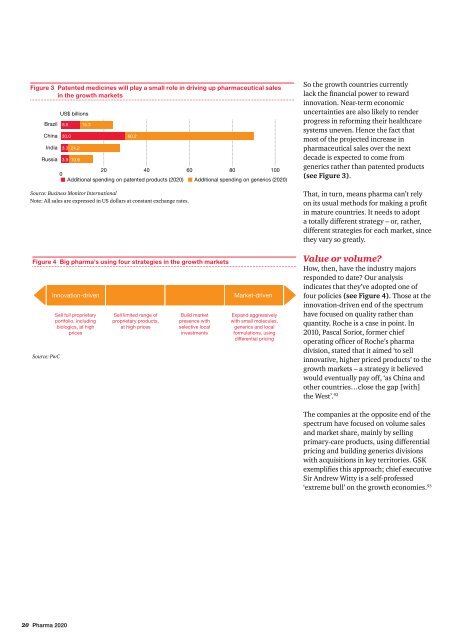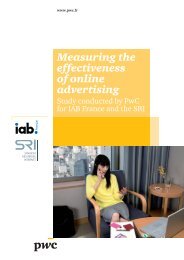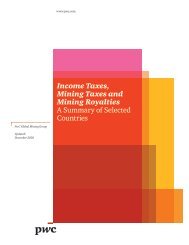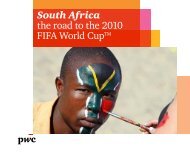From vision to decision Pharma 2020 - pwc
From vision to decision Pharma 2020 - pwc
From vision to decision Pharma 2020 - pwc
Create successful ePaper yourself
Turn your PDF publications into a flip-book with our unique Google optimized e-Paper software.
Figure 3 Patented medicines will play a small role in driving up pharmaceutical sales<br />
in the growth markets<br />
Brazil<br />
China<br />
India<br />
Russia<br />
US$ billions<br />
8.8 15.3<br />
30.0 60.2<br />
3.3 24.2<br />
3.9 10.9<br />
20 40 60 80 100<br />
0<br />
Additional spending on patented products (<strong>2020</strong>) Additional spending on generics (<strong>2020</strong>)<br />
Source: Business Moni<strong>to</strong>r International<br />
Note: All sales are expressed in US dollars at constant exchange rates.<br />
Figure 4 Big pharma’s using four strategies in the growth markets<br />
Source: PwC<br />
Innovation-driven<br />
Sell full proprietary<br />
portfolio, including<br />
biologics, at high<br />
prices<br />
Sell limited range of<br />
proprietary products,<br />
at high prices<br />
Build market<br />
presence with<br />
selective local<br />
investments<br />
Market-driven<br />
Expand aggressively<br />
with small molecules,<br />
generics and local<br />
formulations, using<br />
differential pricing<br />
So the growth countries currently<br />
lack the financial power <strong>to</strong> reward<br />
innovation. Near-term economic<br />
uncertainties are also likely <strong>to</strong> render<br />
progress in reforming their healthcare<br />
systems uneven. Hence the fact that<br />
most of the projected increase in<br />
pharmaceutical sales over the next<br />
decade is expected <strong>to</strong> come from<br />
generics rather than patented products<br />
(see Figure 3).<br />
That, in turn, means pharma can’t rely<br />
on its usual methods for making a profit<br />
in mature countries. It needs <strong>to</strong> adopt<br />
a <strong>to</strong>tally different strategy – or, rather,<br />
different strategies for each market, since<br />
they vary so greatly.<br />
Value or volume?<br />
How, then, have the industry majors<br />
responded <strong>to</strong> date? Our analysis<br />
indicates that they’ve adopted one of<br />
four policies (see Figure 4). Those at the<br />
innovation-driven end of the spectrum<br />
have focused on quality rather than<br />
quantity. Roche is a case in point. In<br />
2010, Pascal Soriot, former chief<br />
operating officer of Roche’s pharma<br />
di<strong>vision</strong>, stated that it aimed ‘<strong>to</strong> sell<br />
innovative, higher priced products’ <strong>to</strong> the<br />
growth markets – a strategy it believed<br />
would eventually pay off, ‘as China and<br />
other countries…close the gap [with]<br />
the West’. 92<br />
The companies at the opposite end of the<br />
spectrum have focused on volume sales<br />
and market share, mainly by selling<br />
primary-care products, using differential<br />
pricing and building generics di<strong>vision</strong>s<br />
with acquisitions in key terri<strong>to</strong>ries. GSK<br />
exemplifies this approach; chief executive<br />
Sir Andrew Witty is a self-professed<br />
‘extreme bull’ on the growth economies. 93<br />
20 <strong>Pharma</strong> <strong>2020</strong>
















